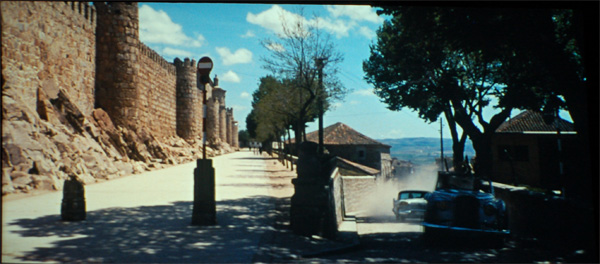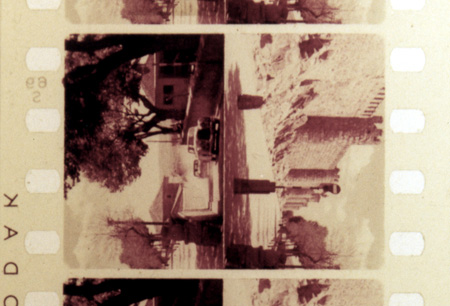ARC-120 Gives Wider Vistas |
This article first appeared in |
| Reprinted from The Ideal Kinema, November 1960 | Issue 66 - November 2001 |
|
|
Further in 70mm reading: |
Special printers |
|
 Electronically
re-composed in Photoshop. Electronically
re-composed in Photoshop.Installed at Denham Laboratories are three special printers which from any type of large-frame negative - CinemaScope, Technirama, VistaVision - will produce an Arc-120 print. (Obviously, it is desirable that the original shall have a large picture-format in order to secure maximum definition in the two half-images). The optical system made by Zeiss-Ikon, which fits to any projector and projects this special print, was shown at Photokina this year. By means of prisms, the half-images are rotated 90 degrees and each is projected through its own lens upon one half of the screen. Naturally there is a dividing line between the two half-frames. In order to make this line almost invisible, the optical system includes a tiny shutter rotating at high speed, which serves to mask the overlap. At the Palace, Blackpool, where the British Lion Film "Honeymoon" (in Eastmancolor) ran for 4½ weeks, Arc-120 was projected on BTH Supa Projectors, fitted with specially selected intermittent movements to ensure maximum steadiness and with the Zeiss-Ikon attachment; the arcs ran at 90 amps. |
|
 Almost
the same scene as above as seen in the restored film. Almost
the same scene as above as seen in the restored film.The 55ft x 22 ft Perlux screen, curved to a depth of 10 ft, was suspended in front of the proscenium. The local press was enthusiastic in its reception. Inventor of Arc-120 is Dr. Leon W. Wells, who claims as a major advantage that the loss of picture quality often due to anamorphic lenses is eliminated. As compared with anamorphic prints, the film frame is slightly larger, hence a better quality picture may be expected, while, because the screen is covered by two separate lenses, a deeply curved screen may be used without loss of definition at the edges. Arc-120 is being launched in this country by Leon Bronesky. An aspect that will appeal to the smaller exhibitor is that he can install the system without capital outlay: Mr. Bronesky is prepared to install the equipment and supply programmes on sharing terms. There are a few other details about Arc-120 in the June 2000 and December 2000 (..in 70mm - Issues 61 and 63). Editor. |
|
|
Go: back
- top - back issues Updated 22-01-25 |

